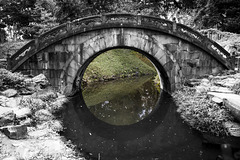
Tokyo - Traditional
Folder: Japan
Meiji Jingu 01 - Minami Shinmon gate
| |
|
|
|
明治神宮, Meiji Jingū is a shrine dedicated to the deified spirits of Emperor Meiji and his consort, Empress Shoken. The shrine was completed and dedicated to the Emperor Meiji and the Empress Shoken in 1920, eight years after the passing of the emperor and six years after the passing of the empress. The shrine was destroyed during the Second World War but was rebuilt shortly thereafter. The present iteration of the shrine was funded through a public fund raising effort and completed in October, 1958.
Emperor Meiji was the first emperor of modern Japan. He was born in 1852 and ascended to the throne in 1867 at the peak of the Meiji Restoration when Japan's feudal era came to an end and the emperor was restored to power. During the Meiji Period Japan modernized and westernized significantly.
Meiji Jingu is one of the Japan's most popular shrines. In the first days of the New Year the shrine regularly welcomes more than three million visitors for the year's first prayers (hatsumode), more than any other shrine or temple in the country. During the rest of the year, traditional Shinto weddings can often be seen taking place there.
Meiji Jingu 02 - view to the shrine
| |
|
|
Meiji Jingu 05 - Traditional Shinto Wedding
| |
|
|
|
Meiji Jingu 06 - Traditional Shinto Wedding
| |
|
|
|
Meiji Jingu 04 - Kaguarden
| |
|
|
Meiji Jingu 03 - Kaguraden
| |
|
|
明治神宮, Meiji Jingū is a shrine dedicated to the deified spirits of Emperor Meiji and his consort, Empress Shoken. The shrine was completed and dedicated to the Emperor Meiji and the Empress Shoken in 1920, eight years after the passing of the emperor and six years after the passing of the empress. The shrine was destroyed during the Second World War but was rebuilt shortly thereafter. The present iteration of the shrine was funded through a public fund raising effort and completed in October, 1958.
Emperor Meiji was the first emperor of modern Japan. He was born in 1852 and ascended to the throne in 1867 at the peak of the Meiji Restoration when Japan's feudal era came to an end and the emperor was restored to power. During the Meiji Period Japan modernized and westernized significantly.
Meiji Jingu is one of the Japan's most popular shrines. In the first days of the New Year the shrine regularly welcomes more than three million visitors for the year's first prayers (hatsumode), more than any other shrine or temple in the country. During the rest of the year, traditional Shinto weddings can often be seen taking place there.
Meiji Jingu 07 - Prayers
| |
|
|
Instruction for the prayers:
„Please write down your prayers, in a faithful spirit of respect and devotion. Please place your offering inside the envelope along with your prayers.
Please use the proper form to write down your requests and expressions of gratitude to deities, your aspirations for this year and othe wishes and prayers. When you are done, place the form in one oft he envelopes provided, together with your token offering for submission.
The written prayer form that you submit will be placed before the Shrine’s altar, with reports duly made tot he deities.
- World Peace
- Universal Harmony
- Business Prosperity
- Family Health
- Recovery from Illness
- Marriage
- Family Security
- Matrimonial Contentment
- Children’s Health
- Achievement of Ambitions
- Good Luck and Protection from Misfortune
- Improved Academic Performance
- Entrance Examination Success
- Prayers for Victory
- Fraffic Safety
- Safety in Travel
- Safe Passage
Meiji Jingu 08 - Sake Barrels
| |
|
|
|
Content of the inscription:
„During the Meiji Era, Emperor Meiji, whose divine soul is enshrined here at Meji Jingu, led the industrial growth and modernization of Japan by encouraging various industries and supporting technological development.
Due to theirgrace and virtue, Emperor Meiji and his consort, Empress Shoken, the beloved mother of our nation whose soul is also enshrined here, are held in the highest esteem by the Japanese people.
These sake barrels are offered every year tot he enshrined deities by members oft he Meiji Jingu Zenkoku Shuzo Keishinkai (Meiji Jingu Nationwide Sake Brewers Association) including the Kotokai, which has made offerings of sake for generations, as well as other sake brewers around Japan wishing to show their deep respect fort he souls of Emperor Meiji and Empress Shoken.
In addition to stating humble gratitude to all oft he brewers who have so graciously donated their sake, we also pray fort he continuous prosperty oft he sake brewing industry and all the other industries maintaining Japan’s traditional culture.“
Fenced Reflections
The Eye of the Bridge is the moon - HFF!
Jump to top
RSS feed- Latest items - Subscribe to the latest items added to this album
- ipernity © 2007-2024
- Help & Contact
|
Club news
|
About ipernity
|
History |
ipernity Club & Prices |
Guide of good conduct
Donate | Group guidelines | Privacy policy | Terms of use | Statutes | In memoria -
Facebook
Twitter










